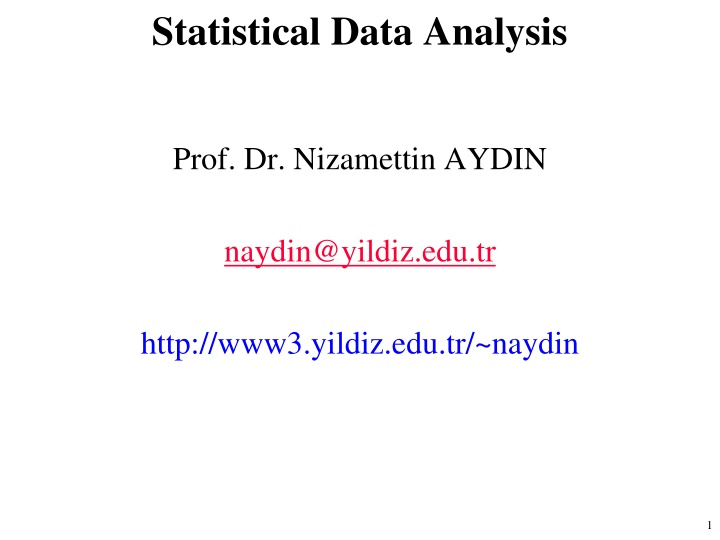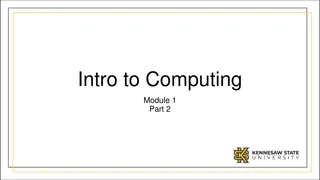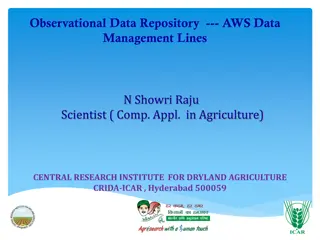
Introduction to R Programming Language and Statistics Analysis
"Explore the world of R programming language and statistical data analysis, including the history of R, its features, comparisons with other languages, package management, and official tutorials. Learn from Prof. Dr. Nizamettin AYDIN."
Download Presentation

Please find below an Image/Link to download the presentation.
The content on the website is provided AS IS for your information and personal use only. It may not be sold, licensed, or shared on other websites without obtaining consent from the author. If you encounter any issues during the download, it is possible that the publisher has removed the file from their server.
You are allowed to download the files provided on this website for personal or commercial use, subject to the condition that they are used lawfully. All files are the property of their respective owners.
The content on the website is provided AS IS for your information and personal use only. It may not be sold, licensed, or shared on other websites without obtaining consent from the author.
E N D
Presentation Transcript
Statistical Data Analysis Prof. Dr. Nizamettin AYDIN naydin@yildiz.edu.tr http://www3.yildiz.edu.tr/~naydin 1
The R Project Environment for statistical computing and graphics Free software Associated with simple programming language Similar to S and S-plus www.r-project.org 3
R, S and S-plus S is an interactive environment for data analysis developed at Bell Laboratories since 1976 1988 - S2: RA Becker, JM Chambers, A Wilks 1992 - S3: JM Chambers, TJ Hastie 1998 - S4: JM Chambers Exclusively licensed by AT&T/Lucent to Insightful Corporation, Seattle WA. Product name is S-plus . Implementation languages C, Fortran. 4
R, S and S-plus R is initially written by Ross Ihaka and Robert Gentleman at Dep. of Statistics of University of Auckland, New Zealand during 1990s. GNU General Public License (GPL) can be used by anyone for any purpose Open Source efficient bug tracking and fixing system supported by the user community http://cm.bell-labs.com/cm/ms/departments/sia/S/history.html 5
Compiled C vs Interpreted R C requires a complete program to run Program is translated into machine code Can then be executed repeatedly R can run interactively Statements converted to machine instructions as they are encountered This is much more flexible, but also slower R Programming Language Interpreted language 6
R and statistics Packaging: a crucial infrastructure to efficiently produce, load and keep consistent software libraries from (many) different sources / authors Statistics: most packages deal with statistics and data analysis State of the art: many statistical researchers provide their methods as R packages 7
Tutorials From R website under Documentation Manual is the listing of official R documentation An Introduction to R R Language Definition Writing R Extensions R Data Import/Export R Installation and Administration The R Reference Index 8
Tutorials Contributed documentation are tutorials and manuals created by R users Simple R R for Beginners Practical Regression and ANOVA Using R R FAQ Mailing Lists (listserv) r-help 9
Interactive R R defaults to an interactive mode A prompt > is presented to users Each input expression is evaluated and a result returned 10
R as a Calculator > 1 + 1 [1] 2 > 2 + 3 * 4 [1] 14 > 3 ^ 2 [1] 9 > exp(1) [1] 2.718282 > sqrt(10) [1] 3.162278 > pi [1] 3.141593 > 2*pi*6378 # Circumference of earth at equator (in km) [1] 40074.16 # Simple Arithmetic # Operator precedence # Exponentiation # Basic mathematical functions are available # The constant pi is predefined 11
R as a Calculator > log2(32) [1] 5 > seq(0, 5, length=6) [1] 0 1 2 3 4 5 > plot(sin(seq(0, 2*pi, length=100))) 12
Variables in R Numeric Store floating point values > a = 49 Boolean (T or F) Values corresponding to True or False > a = (1+1==3) > a [1] FALSE Strings Sequences of characters a = "The dog ate my homework" > sub("dog","cat",a) [1] "The cat ate my homework Type determined automatically when variable is created with "<-" operator 13
R as a Smart Calculator > x <- 1 > y <- 3 > z <- 4 > x * y * z [1] 12 # Can define variables # using "<-" operator to set values > X * Y * Z Error: Object "X" not found # Variable names are case sensitive > This.Year <- 2004 # Variable names can include period > This.Year [1] 2004 14
Missing Values Variables of each data type (numeric, character, logical) can also take the value NA: not available. NA is not the same as 0 NA is not the same as "" NA is not the same as FALSE Any operations (calculations, comparisons) that involve NA may or may not produce NA: > NA==1 [1] NA > 1+NA [1] NA > max(c(NA, 4, 7)) [1] NA > max(c(NA, 4, 7), na.rm=T) [1] 7 > NA | TRUE [1] TRUE > NA & TRUE 15
Functions and Operators Functions do things with data Input : function arguments (0,1,2, ) Output : function result (exactly one) Example: add = function(a,b) { result = a+b return(result) } Operators: Short-cut writing for frequently used functions of one or two arguments. Examples: + - * / ! & | %% 16
R Vectors An ordered collection of data of the same type Created with c() to concatenate elements or sub-vectors > a = c(1,2,3) > a*2 [1] 2 4 6 rep() to repeat elements or patterns seq() or m:n to generate sequences Most mathematical functions and operators can be applied to vectors Without loops! 17
Defining Vectors > rep(1,10) [1] 1 1 1 1 1 1 1 1 1 1 > seq(2,6) [1] 2 3 4 5 6 > seq(4,20,by=4) [1] 4 8 12 16 20 > x <- c(2,0,0,4) > y <- c(1,9,9,9) > x + y [1] 3 9 9 13 > x * 4 [1] 8 0 0 16 > sqrt(x) [1] 1.41 0.00 0.00 2.00 # repeats the number 1, 10 times # sequence of integers between 2 and 6 # equivalent to 2:6 # Every 4th integer between 4 and 20 # Creates vector with elements 2,0,0,4 # Sums elements of two vectors # Multiplies elements # Function applies to each element # Returns vector 18
Accessing Vector Elements Use the [ ] operator to select elements To select specific elements: Use index or vector of indexes to identify them To exclude specific elements: Negate index or vector of indexes Alternative: Use vector of T and F values to select subset of elements 19
Accessing Vector Elements > x <- c(2,0,0,4) > x[1] [1] 2 > x[-1] [1] 0 0 4 > x[1] <- 3 ; x [1] 3 0 0 4 > x[-1] = 5 ; x [1] 3 5 5 5 > y < 9 [1] TRUE FALSE FALSE FALSE > y[4] = 1 > y < 9 [1] TRUE FALSE FALSE TRUE > y[y<9] = 2 > y [1] 2 9 9 2 # Select the first element, equivalent to x[c(1)] # Exclude the first element # Compares each element, returns result as vector # Edits elements marked as TRUE in index vector 20
Matrices and Arrays matrix: a rectangular table of data of the same type example: the expression values for 10000 genes for 30 tissue biopsies: a matrix with 10000 rows and 30 columns. array: 3-,4-,..dimensional matrix example: the red and green foreground and background values for 20000 spots on 120 chips: a 4 x 20000 x 120 (3D) array. 21
Lists vector: an ordered collection of data of the same type. > a = c(7,5,1) > a[2] [1] 5 list: an ordered collection of data of arbitrary types. > x = list(ad="ali", yas=30, bekar=F) Typically, vector elements are accessed by their index (an integer), list elements by their name (a character string). But both types support both access methods. the following all retrieve ad: > x$ad > x["ad"] [1] "ali" [1] "ali" > x[1] [1] "ali" > x[-2:-3] [1] "ali" 22
Data Frames Group a collection of related vectors Most of the time, when data is loaded, it will be organized in a data frame It is a rectangular table with rows and columns; data within each column has the same type (e.g. number, text, logical), but different columns may have different types. Example: > a localization tumorsize progress XX348 proximal XX234 distal XX987 proximal 6.3 FALSE 8.0 TRUE 10.0 FALSE 23
Setting Up Data Sets Load from a text file using read.table() Parameters header, sep, and na.strings control useful options read.csv() and read.delim() have useful defaults for comma or tab delimited files Create from scratch using data.frame() Example: data.frame(height=c(150,160), weight=(65,72)) 24
Blood Pressure Data Set HEIGHT 172 72 166 174 176 166 163 ... Read into R using: bp <- read.table( bp.txt , header=T, na.strings=c( x )) WEIGHT WAIST 91 80 79 55 76 HIP BPSYS 94 1 27.5 107 172.5 101 123 100 117 94 100 99 160 BPDIA 80 100 64 76 60 87.5 87 109 95 93 70 96 25
Accessing Data Frames Multiple ways to retrieve columns The following all retrieve weight data: > bp[ WEIGHT ] > bp[,2] > bp$WEIGHT The following excludes weight data: > bp[,-2] 26
Factors A character string can contain arbitrary text. Sometimes it is useful to use a limited vocabulary, with a small number of allowed words. A factor is a variable that can only take such a limited number of values, which are called levels. > a [1] Kolon(Rektum) Magen [4] Magen Magen [7] Magen Magen(retrogastral) Magen Levels: Kolon(Rektum) Magen Magen(retrogastral) Retroperitoneal Magen Retroperitoneal 27
Factors > class(a) [1] "factor" > as.character(a) [1] "Kolon(Rektum)" "Magen" [4] "Magen" [7] "Magen" > as.integer(a) [1] 1 2 2 2 2 4 2 3 2 > as.integer(as.character(a)) [1] NA NA NA NA NA NA NA NA NA NA NA NA Warning message: NAs introduced by coercion "Magen" "Retroperitoneal" "Magen" "Magen(retrogastral)" "Magen" 28
Subsetting Individual elements of a vector, matrix, array or data frame are accessed with "[ ]" by specifying their index, or their name > a localisation proximal distal proximal tumorsize 6.3 8.0 10.0 progress 0 1 0 XX348 XX234 XX987 > a[3, 2] [1] 10 > a["XX987", "tumorsize"] [1] 10 > a["XX987",] localisation proximal tumorsize 10 progress 0 XX987 29
Subsetting > a localisation proximal distal proximal tumorsize 6.3 8.0 10.0 progress 0 1 0 XX348 XX234 XX987 subset rows by a vector of indices > a[c(1,3),] localisation XX348 proximal XX987 proximal subset rows by a logical vector > a[c(T,F,T),] localisation XX348 proximal XX987 proximal tumorsize 6.3 10.0 progress 0 0 tumorsize 6.3 10.0 progress 0 0 30
Subsetting > a localisation proximal distal proximal tumorsize 6.3 8.0 10.0 progress 0 1 0 XX348 XX234 XX987 subset a column > a$localisation [1] "proximal" comparison resulting in logical vector > a$localisation=="proximal" [1] TRUE FALSE TRUE subset the selected rows > a[ a$localisation=="proximal", ] localisation XX348 proximal XX987 proximal "distal" "proximal" tumorsize 6.3 10.0 progress 0 0 31
Common Forms of Data in R Variables are created as needed Numeric values Vectors Data Frames Lists Used some simple functions: c(), seq(), read.table(), 32
Programming Constructs Grouped Expressions Control statements if else for loops repeat loops while loops next, break statements 33
Grouped Expressions {expr_1; expr_2; } Valid wherever single expression could be used Return the result of last expression evaluated Relatively similar to compound statements in C 34
Branching (if else ) if (expr_1) expr_2 else expr_3 The first expression should return a single logical value Operators && or || may be used Conditional execution of code if (logical expression) { statements } else { alternative statements } else branch is optional 35
Example: if else # Standardize observation i if (sx[i] == "male") { z[i] <- (obsrvd[i] - males.mean) / males.sd; } else { z[i] <- (obsrvd[i] - females.mean) / females.sd; 36
Loops (for) When the same or similar tasks need to be performed multiple times; for all elements of a list; for all columns of an array; etc. for (name in expr_1) expr_2 name is the loop variable expr_1 is often a sequence e.g. 1:20 e.g. seq(1, 20, by = 2) 37
Example: for # Sample M random pairings in a set of N objects for (i in 1:M) { # As shown, the sample function returns a single # element in the interval 1:N p = sample(N, 1) q = sample(N, 1) # Additional processing as needed ProcessPair(p, q); } 38
repeat repeat expr Continually evaluate expression Loop must be terminated with break statement 39
Example: repeat # Sample with replacement from a set of N objects # until the number 615 is sampled twice M <- matches <- 0 repeat { # Keep track of total connections sampled M <- M + 1 # Sample a new connection p = sample(N, 1) # Increment matches whenever we sample 615 if (p == 615) matches <- matches + 1; # Stop after 2 matches if (matches == 2) break; } 40
while while (expr_1) expr_2 While expr_1 is false, repeatedly evaluate expr_2 break and next statements can be used within the loop 41
Example: while # Sample with replacement from a set of N objects # until 615 and 815 are sampled consecutively match <- false while (match == false) { # sample a new element p = sample(N, 1) # if not 615, then goto next iteration if (p != 615) next; # Sample another element q = sample(N, 1) # Check if we are done if (q != 815) match = true; } 42
Example: for and while for (i in 1:10) { print(i*i) } i=1 while (i<=10) { print(i*i) i = i+1 } 43
lapply, sapply, apply When the same or similar tasks need to be performed multiple times for all elements of a list or for all columns of an array. May be easier and faster than for loops lapply( li, fct ) To each element of the list li, the function fct is applied. The result is a list whose elements are the individual fct results. > li = list("ali","mehmet","zeynep") > lapply(li, toupper) [[1]] [1] "AL " [[2]] [1] "MEHMET" [[3]] [1] "ZEYNEP" 44
lapply, sapply, apply sapply( li, fct ) Like lapply, but tries to simplify the result, by converting it into a vector or array of appropriate size > li = list("ali","mehmet","zeynep") > sapply(li, toupper) [1] "AL " "MEHMET" "ZEYNEP > fct = function(x) { return(c(x, x*x, x*x*x)) } > sapply(1:5, fct) [,1] [,2] [,3] [,4] [,5] [1,] 1 2 3 4 5 [2,] 1 4 9 16 25 [3,] 1 8 27 64 125 45
lapply, sapply, apply apply( arr, margin, fct ) Applies the function fct along some dimensions of the array arr, according to margin, and returns a vector or array of the appropriate size. > x [,1] [,2] [,3] [1,] 5 7 0 [2,] 7 9 8 [3,] 4 6 7 [4,] 6 3 5 > apply(x, 1, sum) [1] 12 24 17 14 > apply(x, 2, sum) [1] 22 25 20 46
Functions in R Easy to create your own functions in R As tasks become complex, it is a good idea to organize code into functions that perform defined tasks In R, it is good practice to give default values to function arguments Functions can be defined as name <- function(arg1, arg2, ) expression Arguments can be assigned default values: arg_name = expression Return value is the last evaluated expression or can be set explicitly with return() 47
Defining Functions > square <- function(x = 10) x * x > square() [1] 100 > square(2) [1] 4 > intsum <- function(from=1, to=10) { sum <- 0 for (i in from:to) sum <- sum + i sum } > intsum(3) [1] 52 > intsum(to = 3) [1] 6 # Evaluates sum from 3 to 10 # Evaluates sum from 1 to 3 48
Some notes on functions You can print the arguments for a function using args() command > args(intsum) function (from = 1, to = 10) You can print the contents of a function by typing only its name, without the () You can edit a function using > my.func <- edit(my.old.func) 49
Debugging Functions Toggle debugging for a function with debug() / undebug() command With debugging enabled, R steps through function line by line Use print() to inspect variables along the way Press <enter> to proceed to next line > debug(intsum) > intsum(10) 50






















